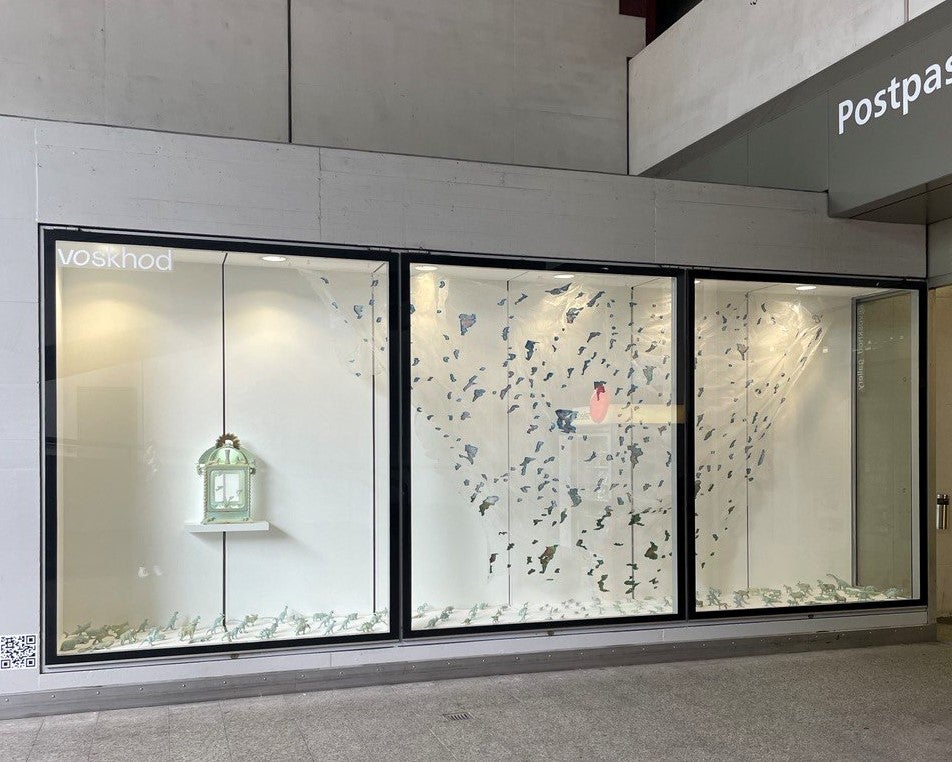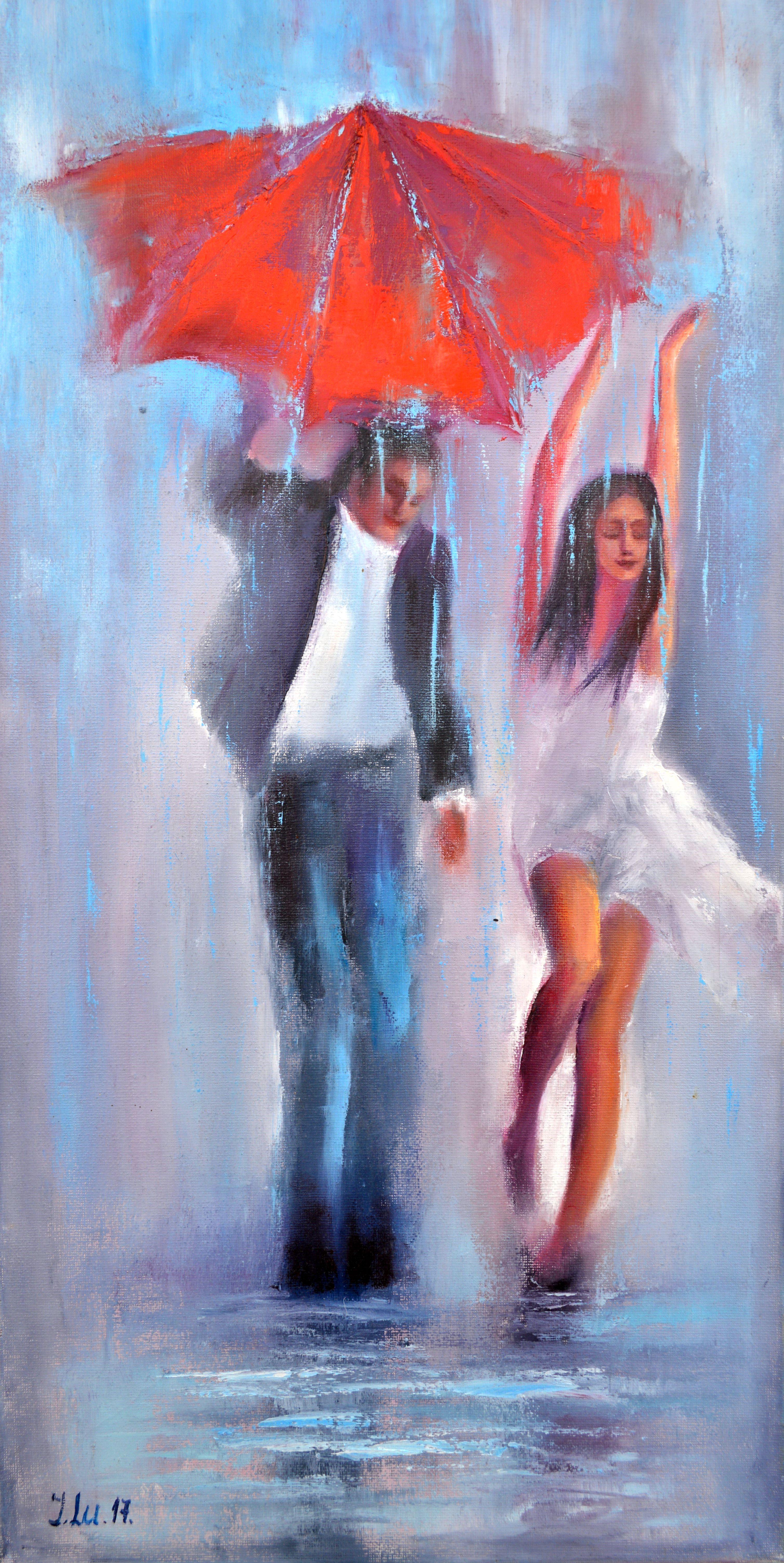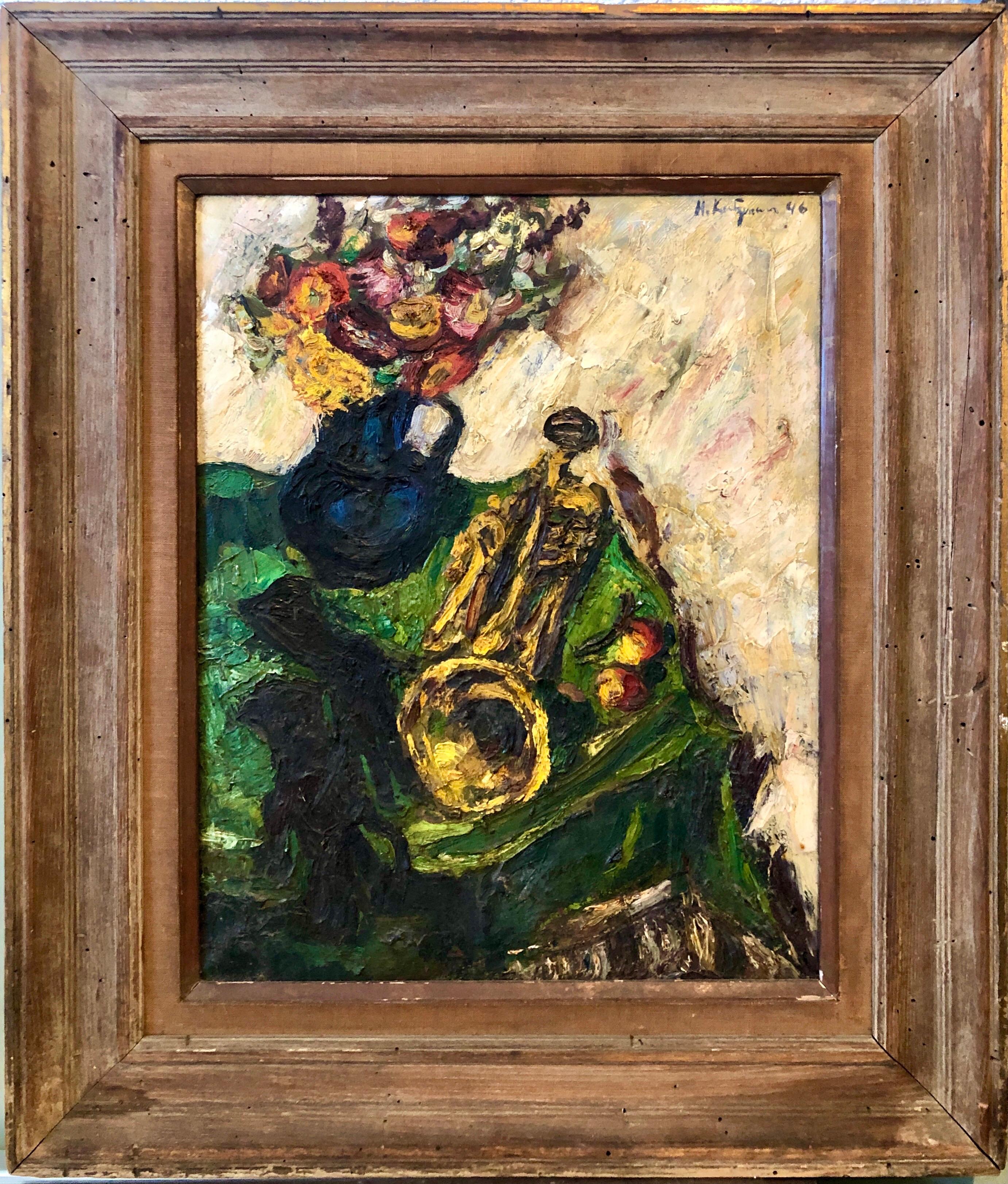Items Similar to In The Room #5 by Katya Tsareva - Expressionist painting, oil on canvas, 2021
Want more images or videos?
Request additional images or videos from the seller
1 of 5
Katya TsarevaIn The Room #5 by Katya Tsareva - Expressionist painting, oil on canvas, 20212021
2021
About the Item
The Room #4 is the 4th work in "In The Room" series by contemporary artist Katya Tsareva. In this series the artist continues to analyze the difficult relationship between human being and living space.
In this series the artist depicts enclosed rooms with a perspective going deep into the painting, while human bodies are subjected to dramatic deformations, taking unnatural positions, losing contours and gradually transforming into menacing poisonous plants (in this case we see the completed transformation, with the red substance on the floor suggesting the remainings of a human). Using the aesthetics of modern spaces Katya exacerbates the conflict between "pure" forms and their artificial anti-human essence, which cannot but affect inhabitants' mental state. Despite the obvious references to the 20th century architecture, the artist speaks about today: the future envisioned by Corbusier has now become a reality and we should learn how to live in it. The works evoke the feelings of liminality and eeriness, making the viewer look deeper inside oneself and reflect.
-
Katya Tsareva was born in 1984 in Krasnodar, Russia. In 2006 she graduated from Kuban State University, where she studied architecture and design. Since then Katya had become a multidisciplinary artist and in 2017 she was named as one of the top 100 young Russian artists, according to the Russian “In Art” database. Her works capture new collective narratives expressing contemporary cultural values, echoing dichotomies of human identity. Her recent solo exhibitions include:
2021 - In My White Corner / Pro Art`s Gallery / Kaluga / Russia
2020 - My Rooms / Futuro Gallery / Nizhni Novgorod / Russia
2018 - Search Me In The Flowers / Udmurt Republican Art Museum / Izhevsk / Russia Supported by PERMM Museum Of Contemporary Art.
2016 - The Story Of A One White House / GridchinHall / Moscow / Russia
- Creator:Katya Tsareva (1984, Russian)
- Creation Year:2021
- Dimensions:Height: 47.25 in (120 cm)Width: 31.5 in (80 cm)
- Medium:
- Movement & Style:
- Period:
- Framing:Framing Options Available
- Condition:
- Gallery Location:Basel, CH
- Reference Number:1stDibs: LU1914213279242

About the Seller
No Reviews Yet
Vetted Seller
These experienced sellers undergo a comprehensive evaluation by our team of in-house experts.
Established in 2020
1stDibs seller since 2022
- ShippingRetrieving quote...Ships From: Basel, Switzerland
- Return PolicyA return for this item may be initiated within 14 days of delivery.
More From This SellerView All
- In The Room #4 by Katya Tsareva - Expressionist painting, oil on canvas, 2021Located in Basel, BSThe Room #4 is the 4th work in "In The Room" series by contemporary artist Katya Tsareva. In this series the artist continues to analyze the difficult re...Category
2010s Expressionist Nude Paintings
MaterialsOil, Canvas
- Fire Ball by Anna Taganzeva-Kobzeva - Painting, oil on canvas, 2023Located in Basel, BSThe painting Fire Ball by contemporary artist Anna Taganzeva-Kobzeva was shown at the group exhibition "Floral & Machine" at St. Paulus Church in Basel in 2023. The exhibition delves...Category
2010s Expressionist Figurative Paintings
MaterialsCanvas, Oil
- Running Man 1 by Katya Tsareva - Triptych painting, acrylic on canvas, 2017Located in Basel, BSRunning Man 1 is a vertical triptych, formed of 3 paintings, 40 x 50 cm each. The triptych can be seen as a follow-up on Katya Tsareva's 2016 project "S...Category
2010s Expressionist Figurative Paintings
MaterialsCanvas, Acrylic
- Untitled by Anton Kushaev - Surrealist painting, oil and acrylic on canvas, 2022Located in Basel, BSThe Untitled is part of the series "Frame of Sorrows" created by Anton Kushaev for the installation at Voskhod Gallery's showcase in Basel in 2022. This painting was exhibited in the...Category
2010s Surrealist Figurative Paintings
MaterialsOil, Acrylic, Canvas
- Untitled by Anton Kushaev - Surrealist painting, oil and acrylic on canvas, 2022Located in Basel, BSThe Untitled is part of the series "Frame of Sorrows" created by Anton Kushaev for the installation at Voskhod Gallery's showcase in Basel in 2022. This painting was exhibited in the...Category
2010s Surrealist Figurative Paintings
MaterialsCanvas, Oil, Acrylic
- Untitled by Anton Kushaev - Surrealist painting, oil and acrylic on canvas, 2022Located in Basel, BSThe Untitled is part of the series "Frame of Sorrows" created by Anton Kushaev for the installation at Voskhod Gallery's showcase in Basel in 2022. This painting was exhibited in the...Category
2010s Surrealist Figurative Paintings
MaterialsCanvas, Oil, Acrylic
You May Also Like
- Dancing in the rain 60X30 oil, Valentine’s Day gifts artLocated in Sempach, LUIn this vibrant oil painting, I've captured the essence of unbridled joy and carefree abandon. Two figures dance beneath a crimson umbrella, their movements a blend of expressionism ...Category
2010s Expressionist Interior Paintings
MaterialsOil, Canvas
- Red dress 60X80 oil, Valentine’s Day gifts artLocated in Sempach, LUIn this embodiment of passion and serenity, crafted with oil on canvas, my hand wove the essence of raw emotion into every stroke. I melded expressionism's vigor with realism's detai...Category
2010s Expressionist Figurative Paintings
MaterialsOil, Canvas
- Lady in Red 60X80 oil, Valentine’s Day gifts artLocated in Sempach, LUThis artwork is a passionate symphony in oil, where expressive strokes and vibrant hues of red capture the essence of emotion and movement. It blurs the lines between realism and exp...Category
2010s Expressionist Figurative Paintings
MaterialsOil, Canvas
- Large French Expressionist Oil Painting, Girl, Poupèe, the Doll, Ecole de ParisLocated in Surfside, FLSigned on recto and signed verso, titled, and inscribed Montmartre by the artist. This is a large colorful expressionist painting of a girl doll with long blonde or ginger redhead pigtails. It is titled Poupee 1925 and depicts an Art Deco era flapper girl in a beret. Roger Crusat (French Expressionist artist, poet and lithographer) is known for ballet troupe set design and theatre backdrop painting and architectural motifs. Roger Crusat was born in 1917 in Roussillon, Provence, France. Crusat's early works depict the colorful countryside of Provence in the South of France, As a young man Crusat performed many jobs in the troupe, designing costumes, and even dancing. But, most important, he painted the scenery for the troupe's performances. It was while working in this capacity that he learned the essentials of scenery painting that remain evident in his mature work. Crusat was a student of Andre Fons-Godail at Beaux-Arts in Perpignan when he was called to serve in World War II. After being wounded in 1940, he returned to study under Rene Jaudon at Beaux-Arts in Paris. Crusat was known by his contemporaries as "the Catalan painter of Montmartre" where he lived with his wife until his death in 1994. Cracked and peeling walls framed by rusting water pipes are a common sight in Montmartre. What others considered unnecessary, Crusat included. Water pipes were his cherished motif. Supposed by some to be a symbol of decay and monotony, Crusat's Impressionist water pipes like arteries in the body, convey life. Crusat won the prestigious Prix Populiste for his "Descente d'Eau" (Water Pipes) in 1956. Crusat's mature work retains the essentials of good scenery painting. Intricate detail will not be found, but broad, solid abstract shapes abound. His subtle colors, dense in texture, are meant to compliment his subjects, not distract from them. The critics considered him a lyric expressionist and a "painter of Man" in his portrayal of the anguish of daily life and the regrets of the past. Crusat exhibited at many of the same Salons as the post-impressionists and expressionists. Salon des Independants was co-founded by Georges Seurat. Degas had only one exhibition during his lifetime, and it was at the Galerie Durand Ruel in Paris. Gauguin had also exhibited his Tahitian paintings. Crusat's works were exhibited there in 1955. SELECT AWARDS 1954 Le Prix de la Jeune Peintre 1955 Prix des Amateurs d'Art & des Collectionneurs, Galerie Gazette des Beaux Arts, 140 rue Faubourg St. Honore, Paris Les Jardins des Abbesses purchased by the Republic of France, Prix de la Ville de Marseilles, Prix Othon Friesz 1956 Prix Populiste, Prix de Amedeo Modigliani 1957 Grand Prix International de Vichy, Prix de la Fondation Greenshields 1959 IVeme Grand Prix de Peinture du Festival de Vichy 1967 Le Prix des Amis de Brantôme, Perigord, France 1970 Prix de la Critique Academy de Vernet a Vichy,"La Nuit, Premiere Etude" Roger Crusat, Half-closed shutters , poems enriched with four original lithographs (175 numbered copies) drawn on Henri Deprest's presses on February 13, 1975 , Éditions Matignon 34, 1975. Personal exhibitions Durand-Ruel Gallery, Paris, 1955 [ 1 ] . Galerie Rivière, Paris, november 1958 [ 4 ] . Le Roux and Mathias, auctioneers in Paris, Sale of the Roger Crusat workshop , Hôtel Drouot , Paris, Thursday October 27, 1994 [ 5 ] . Jack's American Bistro, Glens Falls , September- october 2004 [ 6 ] . Collective exhibitions Galerie Roger, Lyon , October 1946 [ 7 ] . Salon des Indépendants , Paris, from 1952 [ 8 ] . Exhibition Discover , Galerie Charpentier , Paris, 1955. Populist Salon, Paris, 1956. Salon des Amis de Brantôme, 1957. Hundred painters and oil - Exhibition on the occasion of the centenary of the first oil drilling , Musée Galliera , october 1958 [ 9 ] . “An artist from Roussillon whose invoice calls for a flattering comparison with that of a Soutine or a Rebeyrolle . Indeed, following their example, he focuses on familiar scenes: Girls on the balcony or in the basket , Laundresses weighing heavily on the iron, draft horses or plucked turkeys, who stand next to a magnificent portrait of a man in a red dressing gown . Hasn't the Prix Populiste already crowned its merits? " - Jean Jacquinot SELECT EXHIBITIONS Galerie La Gentilhommiere, Paris La Salle Arago, Perpignan, Salon des Indépendants, Salon d'Automne Biennale de Menton, Menton Galerie des Jacobins, Lyon Galerie Durand-Ruel, Paris Salon de la Nationale Galerie Bassano, Paris Salon Populiste Salon de Romans Galerie Motte, Geneva, Switzerland Exposition à Quiberville sur Mer - Normandie Galerie Charpentier Salon Confrontation: Bernard Buffet, Roger Crusat, Jean Jansem, Franck Innocent, Jean-Jacques Morvan...Category
Mid-20th Century Expressionist Figurative Paintings
MaterialsCanvas, Oil
- 1950's Expressionist Interior Oil Painting Still Life with Flowers and TrumpetBy Herbert KatzmanLocated in Surfside, FLHerbert Katzman 1923-2004 (American artist active in New york, Illinois and Italy) Oil Painting Dated 1946. Signed. Dimensions; Sight-16" x 20", Frame-23.5" x 27". Provenance: this bears an old stamp verso from Christie's auction house. Herbert Katzman was born in Chicago on Jan. 8, 1923, His father believing that discipline was a good teacher, sent Herbert and Bob to St. John's military academy for their elementary education but it wasn't long before Herbert found his way to the Art Institute of Chicago where he wanted to study sculpting. His Father vehemently objected and refused to finance his studies, but that wasn't enough to discourage the young artist. He put himself through school working as a student janitor and a few other odd jobs. At 17 he entered the Advanced School of the Art Institute, his interest having turned to painting. His study there was briefly interrupted by a short stint in the navy (1942-44). After receiving a medical discharge, he returned to Chicago to work with Boris Anisfeld, who introduced him to German and French Expressionism...Category
Mid-20th Century Expressionist Figurative Paintings
MaterialsOil, Canvas
- Polish French Jewish Artist Oil Painting Girl with Doll, School of Paris JudaicaBy Walter SpitzerLocated in Surfside, FLFramed 27 X 24 inches Sight 18 X 15 inches Walter Spitzer (Polish/French, 1927 - ) born in Cieszyn, Poland. A Polish Jewish Holocaust survivor, he made his first drawings in a concentration camp. Walter Spitzer has lived and worked since WWII in France, where he studied at the École des Beaux Arts in Paris. Walter Spitzer has achieved great renown as a painter and printmaker. Whether in his paintings of Biblical subjects or in lithographs of Shtetl scenes, His humanity was inspired by the writings of Sartre, Montherlant and Kazantzakis, Walter Spitzer is occupied with two great, interlinked themes: man’s inhumanity to man, and the humanity of man. He will surely be recognized in the future as one of the great witnesses to the twentieth-century experience. Walter Spitzer was born in Chieszyn, Poland, the son of a Jewish liqueur producer, and attended the German school there. He began to draw and paint at an early age. In 1939 the Spitzer family was forcibly removed by the Germans to the town of Strzemieszyce, which was turned into a ghetto in 1942. When the ghetto was liquidated in June 1943 Spitzer’s mother was shot, and the sixteen-year-old Walter was deported to Blechhammer, a subcamp of Auschwitz. There he painted portraits of Wehrmacht soldiers and fellow inmates in exchange for food. He was one of the few to survive the evacuation march from Auschwitz to Buchenwald, where to begin with, in late February 1945, he was held in the Little Camp. To enable him to make drawings documenting life in the camp, the Communists organized his transfer to the main camp. While on a death march in early April he made his escape in the vicinity of Jena and was soon in the hands of the Americans. Spitzer served as an interpreter with an American army unit, and at the same time executed numerous drawings depicting the world of the camps. In June 1945 the Americans took him to Paris, where – following the advice of his father, who had died in 1940 – he began to study art at the École des Beaux-Arts in Par the following year. After completing his training as an artist he produced paintings expressing a critical view of the society of his day. In 1955, in commemoration of the camps and the death marches, he executed a cycle of nine etchings in an edition of thirty, which he gave to various museums in Israel and in France. In the 1960s he established himself as an illustrator of exclusive editions of works by such authors as André Malraux, Jean-Paul Sartre, Joseph Kessel and Nikos Kazantzakis. The Six-Day War prompted him to begin painting subjects from Jewish and Biblical history; At age 19, he was asked to make the scenery for the Edouard VII Theater in Paris, which was showing The Dibbuk of Ansky. In 1947 the same theater asked him to make the scenery for the Hill of Life ( Max Zveig). Spitzer has been a member of the Salon d'Automne since 1952. He was the last remaining survivor of the Montparnasse Ecole de Paris. A group of Jewish expats that included Issachar Ber Ryback, Abel Pann, Abraham Mintchine, Isaac Antcher, Alexandre Altmann, Henri Epstein, Mane Katz, Marcel Janco, Gregoire Michonze...Category
1960s Expressionist Figurative Paintings
MaterialsCanvas, Oil
Recently Viewed
View AllMore Ways To Browse
Vincent Tailhardat
Vintage Vinyard
Virgin Mary Rubens
Volodymyr Makarenko
Walter Prescher Van Ed
Warren Boucher
William Baptiste Baird On Sale
Wood Hope Chest With Angels
Wooden Bols
Xavier Bueno
29 Tall 18 Square Table
Alan Furneaux
Alexander Kruse
Alphonse Chigot
Amandyne Steropes
Andrew Piankovski
Arcadian Boy And Dog 17th C
Beryl Goss





